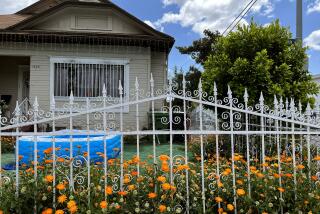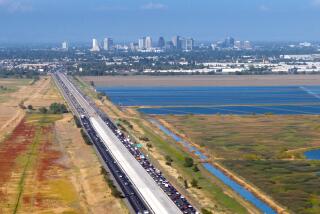Developers Aren’t Getting Free Ride With Sound Walls
- Share via
Dear Street Smart:
I am astounded at the numerous sound walls being constructed. I assume that Caltrans pays for these. I can understand the taxpayers footing the bill for sound walls that go through an existing neighborhood. But are we paying the tab for sound walls on freeways where there are new developments or recently constructed housing? Are developers or homeowners getting a free ride when they choose to build or buy in areas that are freeway-close?
What is the cost to build a wall? When voters are asked to approve propositions to improve traffic conditions (such as the state gas-tax hike and the upcoming Measure M in Orange County) do these propositions include funds for sound walls?
David Farrelly
San Clemente
Actually, there are not nearly as many sound walls as residents along freeways would like. Last year, about $15 million was spent on such partitions, according to the California Department of Transportation. That doesn’t go very far in a state the size of California.
Because few are built, the state has in recent years kept a very closely watched list of candidates for government-funded sound walls. New developments just aren’t on the list, Caltrans officials say. Instead, the money goes to build sound walls in neighborhoods that predate the freeways or in areas where freeway expansion has increased the decibel level, they say.
This doesn’t mean you won’t see sound walls near new developments. Any builder worth his weight in nails knows that it’s a lot easier to sell a house that is “freeway-close” if there’s a well-laid brick wall nearby to quiet the roar of the freeway. But those are financed by the developer, Caltrans says.
Whether publicly or privately funded, sound walls don’t come cheap. The price tag ranges from $500,000 a mile for a wall built out of harm’s way to $1 million a mile for one properly buttressed with steel pilings 16 feet deep to absorb potential impacts from cars and trucks.
As for the ballot measures, they should spark a revival of sound wall construction in the months to come.
The recently approved state gas-tax hike to raise money for transportation projects includes a recommendation for $35 million to finance sound walls in Orange County and millions more elsewhere in the state, authorities say.
Measure M, the November ballot measure that would raise the sales tax in Orange County by half a cent to finance road and rail projects, does not include any money specifically earmarked for sound walls, but new ones will be built along freeways scheduled to be widened with money from the proposition, among them the Santa Ana (5) and Riverside (91) freeways.
Dear Street Smart:
This is in response to comments made by Mr. Robert G. Xiques of Orange regarding motorcyclists and the grudge he perceives automobile drivers have against cyclists.
I have no problem with motorcyclists lane-splitting in bumper-to-bumper traffic at “a reasonable speed.” The problem that is becoming more and more frequent is when traffic is moving and motorcyclists pass between vehicles.
This is the way it often happens: There’s a car in the fast lane and another car directly beside it in the next lane, all moving at 55 m.p.h., when the motorcyclist goes between them, actually riding the dividing line, to get past instead of changing lanes like they are supposed to.
I see instances of this every week. Motorcyclists have the prerogative to go between cars when traffic is stopped, but not when it is moving. It can be very nerve-racking, and it’s one reason auto drivers are annoyed with cyclists.
So stop taking advantage of the width of your vehicle, because it’s creating a potentially dangerous situation for everybody involved.
Gayle L. McKnight
Diamond Bar
Seems like a reasonable request. All it would take is for one of the cars to veer a bit to send both motorcycle and rider bouncing onto the pavement. Not a pretty scenario.
But there are cases in which motorcyclists can legally get away with such a maneuver. Say traffic is rolling along the freeway at 45 m.p.h. A motorcyclist can, under the law, pass between a pair of cars in such a circumstance, according to Steve Kohler, a California Highway Patrol spokesman in Sacramento.
“It’s one of those things that’s permissible and has to be looked at on a case-by-case basis,” Kohler said, noting that there is nothing specifically in the state motor vehicle code that prohibits cyclists from splitting cars.
A Highway Patrol officer, however, does have ways to cite motorcyclists who abuse the rules, Kohler noted. If traffic is moving along at 55 m.p.h. or faster, for instance, any cyclist who passes between a pair of cars could be cited for speeding.
More to Read
Sign up for Essential California
The most important California stories and recommendations in your inbox every morning.
You may occasionally receive promotional content from the Los Angeles Times.










